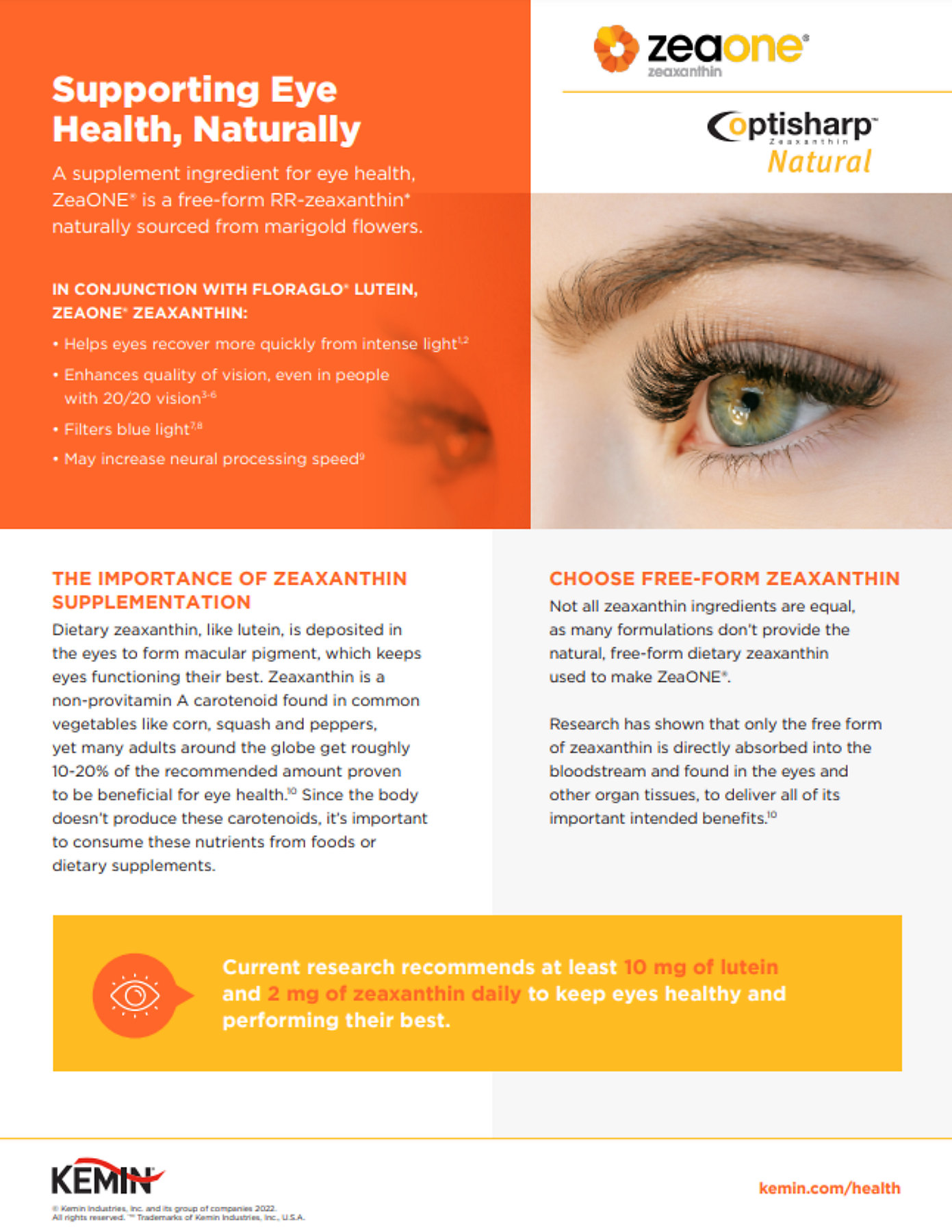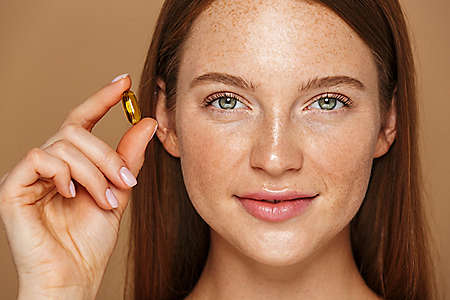You are viewing United States
- United States
- Canada
- Mexico
- South America
- EMENA
- Sub-Saharan Africa
- Russia
- South Asia
- Asia Pacific
- China
A global presence, with local expertise. Visit our regional sites:
- United States
- Canada
- Mexico
Popular Searches
- Human Nutrition & Health
- Carotenoids
- ZeaONE®/OPTISHARP™ Natural Zeaxanthin
ZeaONE®/OPTISHARP™ Natural Zeaxanthin
Together, ZeaONE/OPTISHARP Natural Zeaxanthin and FloraGLO Lutein help absorb potentially damaging blue light and enhance the quality of vision. 1-4
When formulated into a supplement with FloraGLO Lutein, ZeaONE/OPTISHARP Natural Zeaxanthin:
- Help eyes recover more quickly from intense light 5,6
- Enhance the quality of vision, even in people with 20/20 vision 1-4
- Absorb excess blue light 7,8

How much zeaxanthin is needed?
Current research recommends at least 10 mg of lutein and 2 mg of zeaxanthin daily to keep eyes healthy and performing their best. Since the human body doesn't produce these carotenoids for vision, it's important to consume lutein and zeaxanthin from foods or dietary supplements. Most individuals aren't consuming enough fruits and vegetables that contain lutein and zeaxanthin. In fact, most people only get 1 to 2 mg each day, which is far below the amounts proven to be beneficial for eye health.9
ZeaONE/OPTISHARP Natural Zeaxanthin is zeaxanthin naturally sourced from marigold flowers and is a safe, trusted ingredient for eye health. While the highest concentration of this carotenoid is found in the eye, zeaxanthin is also found in the skin, brain and other tissues.
Seed-to-Supplement Zeaxanthin Manufacturer
Dedicated to continuous viability of its natural sources, Kemin is the only company worldwide to have sequenced, assembled and annotated the entire marigold flower genome. Our world-leading breeding program is dedicated to developing hybrids with higher zeaxanthin-accumulation levels and more stable flower yields.
ZeaONE Zeaxanthin is distributed by DSM Nutritional Products as OPTISHARP Natural. Kemin manufactures ZeaONE in accordance with the U.S. FDA Good Manufacturing Process (GMP) facility and delivers it through a carefully controlled supply chain. ZeaONE has received GRAS status from the FDA, making it the first (RR) dietary zeaxanthin from marigold flowers and the first brand of zeaxanthin to be specifically evaluated for safety in pregnant women.
Kemin is committed to responsible and sustainable practices in the production of ZeaONE and in every other aspect of our business. Learn more about how we implement sustainable practices in every step of supplement production, from seed to table or the consumer's hands.
A supplement ingredient for eye health, ZeaONE® is a free-form RR-zeaxanthin* naturally sourced from marigold flowers.

Want to learn more about ZeaONE®/OPTISHARP™ Natural Zeaxanthin?
Fill out the form below and a Kemin representative will be in touch shortly with information on our wholesale zeaxanthin ingredient.
?$featuredContent2$)
Carotenoids

FloraGLO® Lutein

FloraGLO® Lutein for Brain Health

FloraGLO® Lutein for Eye Health

FloraGLO® Lutein for Skin Health
?$featuredContent2$)
ZeaONE®/OPTISHARP™ Natural Zeaxanthin

Macu-LZ™

Macu-LE™
OPTISHARP™ Natural is a Registered Trademark of DSM Nutritional Products Ltd.
OPTISHARP™ Natural is made with ZeaOne(R) from KEMIN. ZeaOne is a [registered] trademark of KEMIN Industries, Inc.
These statements have not been evaluated by the US Food and Drug Administration. This product is not intended to diagnose, treat, cure or prevent any disease.
The information on this webpage is a business-to-business information and not intended for the final consumer. Certain statements may not be applicable in all geographical regions. Product labeling and associated claims differs based upon government requirements and country or region specific information should also be considered when labeling or advertising to final consumers.
This web page and its associated brochures and other documents do not constitute or provide scientific or medical advice, diagnosis, or treatment and are distributed without warranty of any kind, either expressly or implied. This web page, its title or contents and associated brochures and other documents do not in any way make recommendations for health or marketing claims by the reader. Country and region specific regulations should be considered in this regard. Each claim or statement about the effectiveness of Kemin products and/or each claim or statement comparing the effectiveness of Kemin products to the effectiveness of other products is expressly limited to the United States, unless otherwise disclosed on the Kemin websites.
References:
- Stringham, J. M., and Hammond, B. R. (2008) Macular pigment and visual performance under glare conditions, Optom Vis Sci 85, 82-88.
- Rodriguez-Carmona, M., Kvansakul, J., Harlow, J. A., Kopcke, W., Schalch, W., and Barbur, J. L. (2006) The effects of supplementation with lutein and/or zeaxanthin on human macular pigment density and colour vision, Ophthalmic Physiol Opt 26, 137-147.
- Kvansakul, J., Rodriguez-Carmona, M., Edgar, D. F., Barker, F. M., Kopcke, W., Schalch, W., and Barbur, J. L. (2006) Supplementation with the carotenoids lutein or zeaxanthin improves human visual performance, Ophthalmic Physiol Opt 26, 362-371.
- Schalch, W., Cohn, W., Barker, F. M., Kopcke, W., Mellerio, J., Bird, A. C., Robson, A. G., Fitzke, F. F., and van Kuijk, F. J. (2007) Xanthophyll accumulation in the human retina during supplementation with lutein or zeaxanthin - the LUXEA (LUtein Xanthophyll Eye Accumulation) study, Arch Biochem Biophys 458, 128-135.
- Hammond, B. R., et al. (2014). Invest. Ophthalmol. Vis. Sci. 55,8583–8589.
- Liu R, et al. (2014) Invest Ophthalmol Vis Sci. 56:252-258. 5. Yagi, A. et al. (2009). Appl. Ergon. 40, 1047-1054
- Wooten B and Hammond B (2002). Prog Retin Eye Res. 21: 225-240.
- Stringham J and Snodderly D (2013). Invest Ophthalmol Vis Sci. 54: 6298-3606.
- Johnson, E. J., Maras, J. E., Rasmussen, H. M., and Tucker, K. L. (2010) Intake of lutein and zeaxanthin differ with age, sex, and ethnicity, J Am Diet Assoc 110, 1357-1362.
Human Nutrition and Health Blog
Products
Careers
Careers
- California Residents
- California Supply Chain Act
- Email Disclaimer
- GDPR Personal Data Addendum
- General Terms & Conditions for Vendors
- Global Environmental Policy Statement
- Indirect Cost Estimates
- Kemin Terms & Conditions
- Modern Slavery Act Transparency Statement
- Privacy Policy
- Sitemap
© Kemin Industries, Inc. and its group of companies All rights reserved. ® ™ Trademarks of Kemin Industries, Inc., USA
Certain statements may not be applicable in all geographical regions. Product labeling and associated claims may differ based upon government requirements.
You are viewing United States
- United States
- Canada
- Mexico
- South America
- EMENA
- Sub-Saharan Africa
- Russia
- South Asia
- Asia Pacific
- China
A global presence, with local expertise. Visit our regional sites:
- United States
- Canada
- Mexico
Privacy Policy
By browsing this site you permit us and our partners to place identification cookies on your browser and agree to our use of cookies for marketing. Review our cookies policy for details.

